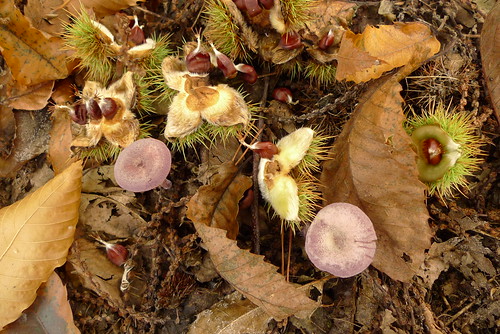Autumnal Compostables and Leaf Mold
I am an avid composter but it is worth considering what is going into your compost this Autumn.
This photo contains several items that are not idea for my compost heap.
- When I spread my compost I do not want lots of new saplings springing up in my garden. Some seeds and nuts are likely to survive composting as the heat will not be as great through winter.
- Leaves particularly Oak, Horse-chestnut and broadleaved trees will be slow to rot down.
- Leaves do not provide much sustenance but are great conditioners if rotted down over a couple of years into leaf mold.
- I have to admit to being uncertain about composting fugus. There seems to be little food value in these mushrooms and they may be spread via the composting process. On the other hand fungi are key parts of a soils organic activity and on balance I would compost these. I would not compost Honey-fungus or anything growing near my fruit trees.
Tips on Making Leaf Mold
- Rake your leaves together into a pile. Bits of soil, grass and a variety of leaves are not a problem but make the pile predominantly leaves.
- Then there are a couple of options:
- Put the leaves in a wire cage cover and leave to rot.
- Put the leaves into a large plastic bag and puncture to allow air to enter.
- Leaves should be damp and can be lightly watered but not left soggy. The rotting will not create heat like normal compost and decomposition will be slow.
- It may take over a year for the leaves to breakdown and the volume will be a tenth of the leaf pile you started with.
- Conifers and evergreen leaves will take  three years to compost and are best added in small quantities.
- Shredding leaves or chopping with a lawnmower first helps to speed up composting.

3 thoughts on “Autumnal Compostables and Leaf Mold”
Comments are closed.